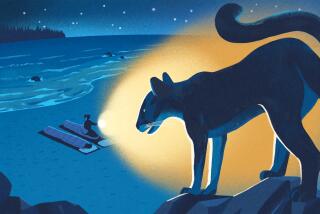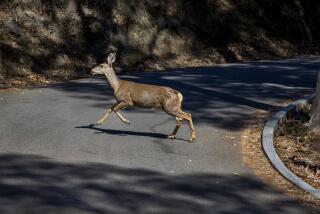Thoreau on the moose
- Share via
All this talk about moose hunting! It is as though, because of the animal’s enormous size and imposing antlers, bringing one down is a heroic feat of marksmanship. Nothing could be further from the truth. As Henry David Thoreau wrote in “The Maine Woods,” killing these big, gentle, myopic creatures is more “like going out by night to some woodside pasture and shooting your neighbor’s horses.”
Thoreau’s descriptions of the moose he saw in Maine are inspired and fanciful. “They made me think of great frightened rabbits,” he wrote, and he alluded to the moose’s “branching and leafy horns -- a sort of fucus or lichen in bone.”
In all his descriptions there is affection and awe. The killing of a moose is, in Thoreau’s view, always a tragedy. He witnessed one being shot, and “nature looked sternly upon me on account of the murder of the moose.” In another passage, Thoreau grudgingly acknowledges that moose are hunted by Indians out of necessity -- for their meat, for their hides, as part of Indian custom and tradition. This was in 1853.
American politicians seldom take notice of American writers, especially the boldest ones, such as Thoreau, whose every word is at odds with their groveling and grandstanding and their sanctimonious cant. Think of the average politician today and then reflect on how Thoreau had no time for organized religion, how he mocked clergymen and jeered at missionaries, warmongers and Bible-thumpers. He was a defender of John Brown and the rebellious spirit in American life, a proponent of human rights.
He hated the thought of the wilderness being opened to development; he wrote scathingly of lumberjacks and logging operations. He would have cheered the demonstrators outside the Republican National Convention in St Paul, Minn. He would have mocked the people inside. He would have denounced the prison at Guantanamo. He wrote against injustice; he despised politicians and hunters.
And yet hunting seems to define a certain species of American politician. It’s nothing new. When Teddy Roosevelt left office, he traveled to Africa and -- in the role of evil twin to the biblical Noah -- hunted and killed two (and sometimes 18) of every species of animal that could be found from the Kenyan coast to the swamps of the southern Sudan: total bag, 512 creatures. In his account of the safari, “African Game Trails” (1910), he wrote, “The land teems with beasts of the chase, infinite in number ... .”
“Infinite” is credulous hyperbole -- many of those animals are now extinct or severely endangered. Take the bongo, a large African antelope -- nearly as large as a moose -- now almost gone because of hunters and poachers. In Uganda, where it roamed in sizable numbers when I lived there, it has been wiped out. Maurice Stans, the Nixon administration Commerce secretary and Watergate defendant, helped to eradicate this gentle animal when, in the 1960s, he sicced his dogs on them -- the conventional way to corner a bongo -- then presumably gestured to his gun bearer (“Here is your bunduki, bwana”) and shot two of them as trophies. It was not an incidental act: Maurice Stans defined himself politically as a big-game hunter.
You would be forgiven for believing that the Menendez brothers gave Dick Cheney lessons in handling a shotgun -- still, he is by all accounts a keen hunter. But who knew that Justice Antonin Scalia also hunts ducks? Perhaps it is not odd that someone who advocates physical harm to humans would not shrink from blowing a small bird apart. Earlier this year, asked about torture, Scalia said: “It seems to me you have to say, as unlikely as that is, it would be absurd to say you couldn’t, I don’t know, stick something under the fingernail, smack him in the face. It would be absurd to say you couldn’t do that.” Cheney agrees, so it is no surprise that these men are hunting buddies, huddled in the same duck blind, torturing animals to death with buckshot.
A lot can be told from the animals that people choose to kill. The French shoot the most melodious larks and turn them into pate. Many English people are still indignant that restrictions have been placed on the hunting of foxes, bongo style, chasing them with dogs, which tear them to pieces.
There is hunting for sport, and hunting for the pot, and of course hunting for votes. The name of Teddy Roosevelt, the hunter, the moose skinner, was invoked just the other day at the Republican National Convention, in Fred Thompson’s praise of Gov. Sarah Palin. This mother of five is now celebrated as a moose hunter and, more than that, moose skinner, moose eater and perhaps hanger of moose-head trophies. As Palin was delivering her acceptance speech, an immense photograph of Alaska was projected behind her on the giant screen where, in the foreground, a moose could be seen, placidly staring at its reflection in water. And on the following day, in the video that encapsulated her life, Palin was described as having risen early on cold mornings with her father to go moose hunting.
Moose hunting is now seen as a possible Republican vote-getter, especially as the moose hunter in question is a slightly built and bespectacled mother of five. This casting against type presumably has the same effect on the public imagination as the revelation that defensive tackle Roosevelt Grier found relaxation in needlepoint.
I have no strong views on hunting, only the usual disgust when I see a creature senselessly slaughtered at no risk to the hunter. Thoreau called the moose “a fabulous animal,” and in a book Palin probably has not read, he remarked on how moose sometimes weigh 1,000 pounds and how they “can step over a five-foot gate in their ordinary walk.”
While people cheered, Palin was lauded for knowing how to “field-dress” a moose. Thoreau, who watched such an operation, wrote, “Joe [his Penobscot guide] now proceeded to skin the moose with a pocket knife, while I looked on, and a tragical business it was; to see that still warm and palpitating body pierced with a knife, to see the warm milk stream from the rent udder, and the ghastly naked red carcass appearing from within its seemly robe.” I read that and somehow am not provoked to cheer.
In one of the great passages, in the chapter “Chesuncook,” Thoreau writes how the moose and the pine tree are linked in his mind. “A pine cut down, a dead pine, is no more a pine than a dead human carcass is a man.” He continues, “Every creature is better alive than dead, men and moose and pine trees, and he who understands it aright will rather preserve life than destroy it.”
Paul Theroux is the author of many books, including “The Great Railway Bazaar,” “The Mosquito Coast” and, most recently, “Ghost Train to the Eastern Star.”
More to Read
Sign up for Essential California
The most important California stories and recommendations in your inbox every morning.
You may occasionally receive promotional content from the Los Angeles Times.










